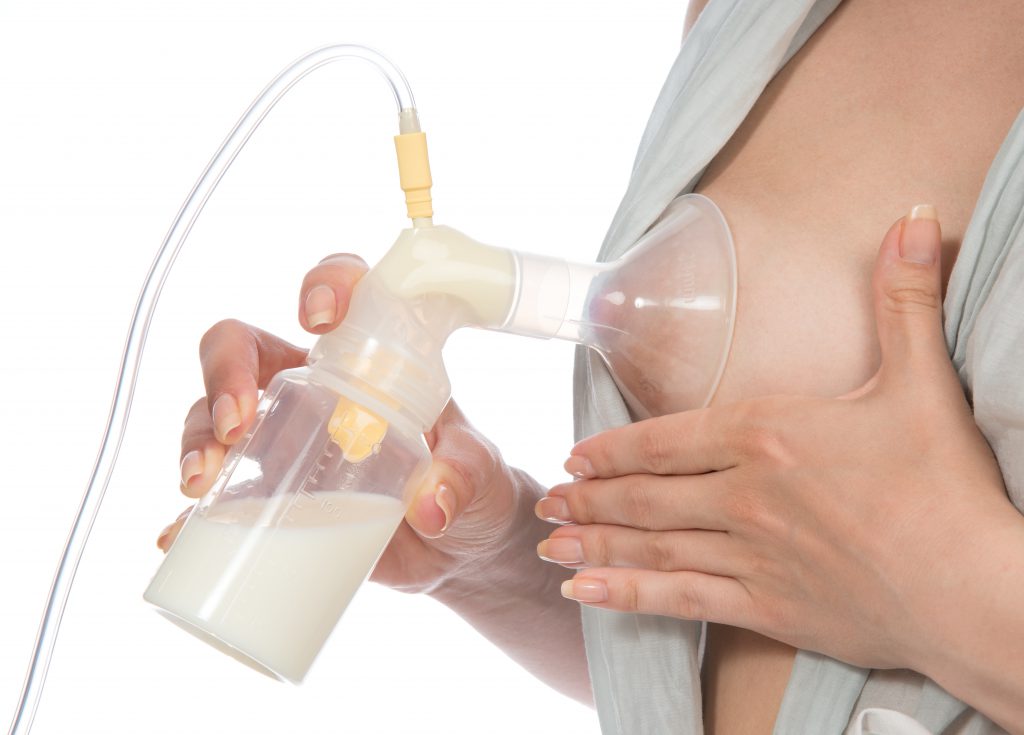
Returning to work after having a baby can be a very stressful time.
From the time my son was born, I was pumping.
Trying everything I could to “bring in my milk” and store as much as I could.
I had been told by well-meaning moms, co-workers, and family that I was going to have to formula feed because there is no way I could pump enough for my son while working the long hours that I did.
I was determined to prove them wrong.
Well, here I am three kids later and a lot wiser. Let me share with you what I learned and how to build a milk freezer stash the right way!

How to Build a Breast Milk Freezer Stash
Most moms, myself included, seem to think that you need this crazy amount of milk stored in the freezer (especially if returning to work)…
You hear other moms talk about the 1,000 ounces they have saved and you are feeling like you are really behind on your game.
Well, let me share something with you that I have learned after working with various lactation consultants and preparing myself to go back to work:
You don’t need 1,000 ounces.
Truth.
Let me explain why.
There is a fine line between needing a freezer stash to get ahead to be prepared for when you need to leave your baby and using the freezer stash to supplement.
If you think back to breastfeeding basics, then you know that nursing is a supply and demand act.
When your baby nurses more often, your body responds by making more milk.
On the flip side, when you nurse less often, your body makes less milk.
Easy, right? More breastfeeding = more milk and less breastfeeding = less milk.
When you start using a freezer stash in place of nursing or pumping sessions, you are telling your body that you no longer need that amount of milk and your supply will start dropping.
Still with me?
 So let’s say you are a working mom and your baby goes to daycare for 10 hours a day.
So let’s say you are a working mom and your baby goes to daycare for 10 hours a day.
Baby eats 4 ounces every 3 hours which equals 12 ounces total while you are at work.
If you are tapping into a freezer stash for one of those bottles and only pump 8 ounces while working, then your body has no idea it needs to produce the extra 4 ounces.
You will be short 4 ounces every day which means your freezer stash will slowly disappear and eventually you will run out since you are not able to add to it.
Now you are out of milk and not pumping enough and the obvious solution is to start supplementing with formula to make up for the lost ounces.
So you can see how this cycle happens and why moms start struggling with their supply.
The best thing to do is to address the real issue at hand which is having a low supply.
(Related: Click here to read how you can increase your milk supply and pump more milk!)
I want to add, that I am NOT against supplementing. Supplementing is necessary in some cases but what I am FOR is the proper education for breastfeeding moms on the proper way to supplement and why and how their body is responding the way that it is.
The read about how to supplement and do it right, click here!
The Right Way to Use a Freezer Stash
So, how do you use a freezer stash without sacrificing your milk supply?
The purpose of a freezer should be for two purposes:
- To have enough milk for the first day back to work or during a time you leave your baby.
- For emergencies. Often times your supply can dip if you get sick, which is temporary, but it is a good idea to have milk on hand just in case.
Also breastfeeding on certain medications is not deemed safe and therefore a freezer stash would come in very handy.
There are also times where you may need to leave your baby with a sitter unexpectedly and having a stash on hand takes a lot of stress off.
(Related: Find out which app acts as a resource for looking up safe medications for breastfeeding.)
**Remember that anytime you use milk from your freezer stash, you need to replace that “feeding” by pumping to ensure your body knows to continue to produce the same amount your baby is taking. Missing a feeding once every so often probably won’t do any harm but it’s good practice to always pump to replace it.**
Again, your freezer stash should not be used to replace feedings where you are not pumping in its place.
Your supply will suffer and you will be on the supplementing-crazy train, which can be hard to get off of.
How to Build a Freezer Stash

Okay now to the good stuff…
How the heck do you build a freezer stash when you have a hungry baby to nurse?
This is a question I get from readers fairly often.
I can tell you that when I was preparing to go back to work after having my first baby, this panicked me. I had no idea where to start.
My nearly four-month-old baby always seemed hungry and I felt I could barely keep up with his demand much less pump extra for a freezer stash.
Well, let me assure you it is possible!
Here is what I found worked best to get those extra ounces:
1 – Start Several Weeks In Advance
If you are returning to work, it is best to start building your stash several weeks before your return date.
If you have been exclusively breastfeeding or pumping and only meeting what baby needs, then you need to give your body some time to adjust to pumping some extra.
It can take some time so don’t get discouraged if you don’t see the ounces piling up in your freezer right away.
So starting early is the key.
It will also mean you feel less pressure and stress.
2 – Take Advantage of Your Morning Supply
 If you have been nursing for any length of time, then you probably have realized that your supply is most abundant in the mornings.
If you have been nursing for any length of time, then you probably have realized that your supply is most abundant in the mornings.
This is a great time to pump and can add some valuable ounces to your stash.
You can go at this a few different ways depending on your schedule:
1. Nurse your baby first and then pump –
I did this most mornings.
This is a great way to not only get a few extra ounces but also to tell your body to make more milk.
Rarely did my baby drain my breasts completely in the mornings so I always had a little extra to spare.
After nursing your baby, pump for about 20 minutes even if nothing comes out.
2. Nurse your baby on one side while pumping the other side –
If I was pressed for time, this was a great option to knock out my morning feed and pump for my stash.
If you block feed (nurse from one side only per feeding) this is the way I would go about pumping.
The best way to accomplish pumping while nursing is to use a nursing bra that doubles as a pumping bra so you can pump hands-free.
Nursing while pumping also will lead to a stronger letdown so if you struggle to pump, give this a try!
3 . Pump one side before baby wakes up and then nurse your baby on the other side later –
This is not something I often did since my babies were early risers so I typically got up with them.
But if you get up before your baby and need to have that extra time, you can opt to pump one side and once your baby wake, feed on the other side.
Just as effective and lets you have some control if you are pressed for time.
(Related: Need a Hands-free pumping bra? Click here to read why it is the best thing ever!)
3 – Add an Evening Pumping Session

I would say the evenings were the time I felt my supply was the lowest.
You may find after returning to work that your baby is attached to you the second you walk in the door. So I was pretty drained by bedtime.
It is important to know that your body is always producing milk.
Many moms believe that their breasts become empty after nursing but research tells us that is not the case.
Your body doesn’t stop producing milk. Breastfeeding just turns on the faucet so to speak.
The faster you let the milk out (through nursing or pumping) the faster your body replaces.
You are never truly empty.
So adding an evening pumping session is a great way to increase your supply because by demanding more from your body, you are asking your body to quickly ramp up and produce more milk.
I typically added this pumping session right after my baby went to bed for the night.
Again, pump for about 20 minutes even if nothing comes out.
4 – Pump After Each Nursing Session
In most cases adding a session to the morning and night, should be sufficient to get a few ounces a day to freeze.
I don’t typically recommend that you pump much more than that as you don’t want to create a huge oversupply as that can lead to other issues like engorgement, clogged ducts, and mastitis.
Yuck.
BUT if you find yourself in need of a supply boost, a great way to help your production along is to pump for 15-20 minutes after your nurse your baby.
This again, tells your body that it needs to kick production up a notch.
You should only do this until your supply comes back up. Trust me, dealing with engorgement issues is NOT worth it!
(Related: For more information on boosting your supply, click here!)
How to Store Pumped Milk
This is another common question I get about building a freezer stash.
The root of the question stems from not wanting to freeze tiny quantities of milk since you likely won’t pump more than an ounce or so each pumping session to start with…
Here are some options for storing the pumped milk for your freezer stash:
1 – Milk should be stored 1-4 ounce per container to avoid waste

Once you thaw or heat the milk, you need to use it or dump it.
So storing more than your baby eats per bottle in one container is wasteful.
2 – Combine Milk from multiple pumping sessions

Milk may be combined from different pumping sessions from different days.
Heres how to do that:
- You need to first refrigerate the pumped milk.
- You CANNOT add warm milk to cooled milk OR cooled milk to frozen milk. They need to be at the same temperature.
- Once the milk is cooled, combine the milk together with previously pumped milk until you have the desired number of ounces to freeze.
- Then put it in the freezer.
- You need to use the date of the oldest milk as the date for the milk to be used by.
(Note: Milk does expire in the fridge, make sure you are not going over that date on any pumped milk when combing from different days).
Click here to read more about Milk Storage Guidelines including how long milk is good for in the fridge!
3 – Try using ice cube trays
Ice cubes are about one ounce each and make a perfect (and cheap) way to freeze your milk.
You can freeze, then pop the cubes into a ziplock bag.
Remember to label the milk using the oldest milk’s date as an expiration/use by date.
If you use wide neck bottles, then a standard ice cube tray would be fine (you need to find one that is food safe with no BPA or dyes).
If you use standard neck bottles or just need a safe brand to use, my favorite is Milkies Milk Trays. They make one-ounce sticks that make slipping into any sized bottle a breeze. You can read about them here.
4 – Use a feeding system
If you pump and work, having a system that you can pump, store, and feed your baby from the same bag is a huge timesaver (money saver too).
I used the Kiinde Twist system with my second baby.
I often get asked what the best way to go about combining milk is when you use a feeding system.
Here’s the long and short, when building a stash, you are not pumping a ton.
I opted to pump into a regular pump bottle, cool the milk in the refrigerator, and then combine into one of the feeding system bags to freeze.
The reason being is I didn’t want to waste one of the Kiinde bags on half an ounce, you know?
The feeding system is great for pumping sessions like when you return to work or pump exclusively but I would stick to pumping into a standard pump bottle when building a stash so you don’t waste a bag.
Make sense?
But I would still freeze in the feeding system bag so you are ready when you need to feed!
The Kiinde Twist is by far my favorite and is well worth the money.
5 – Get Technical
One of the main issues of storing breastmilk while building a freezer stash is keeping track of what you have stored and when it expires.
A great way to organize yourself and keep track of your stash is to use an app!
Using the Milk Stash App
I came across the app Milk Stash a little while back and really have enjoyed using it!
You can log in how much you are pumping, how you stored a bottle (refrigerator, freeze, deep freezer), and when you remove a bottle.
It will keep tracking of how many ounces you have stored and when your milk is set to expire based on the date you pumped it.
It also has some handy tools and graphs to help you see how your supply is keeping up based on how much milk your baby is drinking vs what you are pumping.

This is a huge help for any mom who needs a little help in organizing a freezer stash. I am a disaster in that area so this has been super helpful!
It’s very easy to use and takes one click to add or remove bottles
If you want to download the Milk Stash app, it’s FREE! Click here for that info.
They are also working on launching a Kickstarter (Starts October 17, 2017) for their new Milk Stash Storage Trays.

I have to say, I love the idea of these trays!
The trays fit in your fridge and allow you to store up to 7 bottles.
You basically roll the bottle in the tray and it goes to the back of the line so that you are always grabbing the oldest milk first when you go to warm a bottle.
Super helpful in making sure you are feeding the oldest milk first and for keeping your bottles stored in a very space-saving way.
You can pump, store, and feed from the same bottle so saves time as well!
If you want to read more about the Milk Stash Storage Trays and see it in action, click here!
6 – Get Answers to Your Storage Questions
Want more info on how to store breastmilk and what is safe?
Can you use offer a bottle later if your baby didn’t finish? How long can freshly pumped milk sit out? Can you refreeze thawed milk?
Read more about Proper Breast Milk Storage Guidelines HERE.
Returning to Work
After returning to work, you can continue with your extra pump sessions in the morning and night for a few weeks or so.
That way you can gauge if you are getting enough time to pump while at work to meet the demand of what your baby eats while you are away.
If you are like me, then you probably have a ton of questions about returning to work.
Here are some additional resources to get you through:
 View a Sample Pumping Schedule for Work – Find out what time to pump during an 8 or 12-hour shift, for how long, how often, etc!
View a Sample Pumping Schedule for Work – Find out what time to pump during an 8 or 12-hour shift, for how long, how often, etc!- How Much Milk Does a Breastfed Baby Need – Need to know how much to send per bottle? Find out!
- Timesaving Tips for Pumping at Work – Find out how to pump enough on limited time!
- How to Talk to Your Employer About Pumping at Work – What should you say?
- Reverse Cycling – Find out why your baby may refuse a bottle while you are at work and what to do about it
- Find more on our working and pumping page!
Returning to work can be stressful so preparing early is key.
You can keep up with your baby but it may take some extra effort in the beginning.
Find what works for you and as always, if you have any questions, drop me a comment below! We are in this together!
Happy Pumping!
Related Articles
Follow Me on Pinterest and Find out more about pumping!




